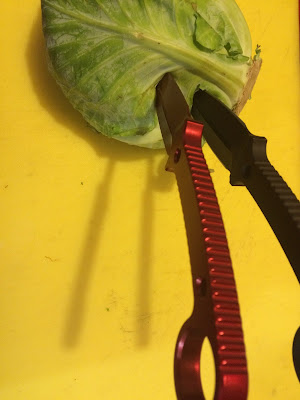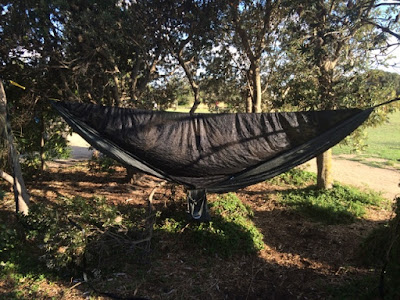
I had a good opportunity come my way in regards to some news to share with you all.
I just got a bundle of pictures and data from a press release from the knifemaking powerhouse of Dwyer Custom Goods.
Dwyer Custom Goods will be represented at SHOT Show 2016 next week, so it's a perfect time to get to know a very fancy maker.
 In particular DCG would
like to invite members of the media and discerning custom knife
aficionados to come and visit with the "better half" of the Dwyer Custom
Goods custom team: Sheila Anders-Stronegger (or as you might better understand: Dwyer Household-6 Actual).
In particular DCG would
like to invite members of the media and discerning custom knife
aficionados to come and visit with the "better half" of the Dwyer Custom
Goods custom team: Sheila Anders-Stronegger (or as you might better understand: Dwyer Household-6 Actual).
Mrs. Dwyer began her knife apprenticeship with Duane Dwyer, Mick Strider and other notables in the custom knife making community in 2009 after a career as a model and on television. In 2013 she began building her blades on her own and is now releasing a number of her own designs.
 “I build knives to be beautiful,” says Sheila,
whose favourite steels to work with are Damascus and SM-100, “but nasty
and dangerous too…a concealable, hard use, capable tool.” I couldn't agree more. As you may have gathered, I much prefer a small quick blade over a big blade, unless I then progress to short swords.
“I build knives to be beautiful,” says Sheila,
whose favourite steels to work with are Damascus and SM-100, “but nasty
and dangerous too…a concealable, hard use, capable tool.” I couldn't agree more. As you may have gathered, I much prefer a small quick blade over a big blade, unless I then progress to short swords.
 “I
started by doing grunt jobs at the shop,” she says. “I’ve done blasting
and polishing, the surface grinder and every other machine in the
place. That’s how you get there, you start at the ground level and
evolve. I love looking at true craftsmanship. I love to learn
from other knife makers; how to improve a lock or a way to perfect a
finish technique. It brings me joy to learn.”
“I
started by doing grunt jobs at the shop,” she says. “I’ve done blasting
and polishing, the surface grinder and every other machine in the
place. That’s how you get there, you start at the ground level and
evolve. I love looking at true craftsmanship. I love to learn
from other knife makers; how to improve a lock or a way to perfect a
finish technique. It brings me joy to learn.”
For more information, or to make an appointment to speak with Mrs. Dwyer, e-mail Dwyer Custom Goods at DDCustomGoods@live.com as her blades are certainly both elegant and deadly looking. Artisinal metalwork just took a step up.
I've gutted to miss yet another US SHOT Show, but have a bunch of friends who are on their way, so look forwards to a detailed brief.


I just got a bundle of pictures and data from a press release from the knifemaking powerhouse of Dwyer Custom Goods.
Dwyer Custom Goods will be represented at SHOT Show 2016 next week, so it's a perfect time to get to know a very fancy maker.
 In particular DCG would
like to invite members of the media and discerning custom knife
aficionados to come and visit with the "better half" of the Dwyer Custom
Goods custom team: Sheila Anders-Stronegger (or as you might better understand: Dwyer Household-6 Actual).
In particular DCG would
like to invite members of the media and discerning custom knife
aficionados to come and visit with the "better half" of the Dwyer Custom
Goods custom team: Sheila Anders-Stronegger (or as you might better understand: Dwyer Household-6 Actual). Mrs. Dwyer began her knife apprenticeship with Duane Dwyer, Mick Strider and other notables in the custom knife making community in 2009 after a career as a model and on television. In 2013 she began building her blades on her own and is now releasing a number of her own designs.
Sheila's
knives are all built by hand, from the profiling to the grind. All are
smaller than other Dwyer Custom and Strider Knives, and while suitable
for a male to carry and fight with, they have an undeniably feminine
influence. Her focus is predominantly on the small and concealable.
 “I build knives to be beautiful,” says Sheila,
whose favourite steels to work with are Damascus and SM-100, “but nasty
and dangerous too…a concealable, hard use, capable tool.” I couldn't agree more. As you may have gathered, I much prefer a small quick blade over a big blade, unless I then progress to short swords.
“I build knives to be beautiful,” says Sheila,
whose favourite steels to work with are Damascus and SM-100, “but nasty
and dangerous too…a concealable, hard use, capable tool.” I couldn't agree more. As you may have gathered, I much prefer a small quick blade over a big blade, unless I then progress to short swords.
Mrs. Dwyer is passionate about building knives, particularly with regard learning from the artisans around her.
 “I
started by doing grunt jobs at the shop,” she says. “I’ve done blasting
and polishing, the surface grinder and every other machine in the
place. That’s how you get there, you start at the ground level and
evolve. I love looking at true craftsmanship. I love to learn
from other knife makers; how to improve a lock or a way to perfect a
finish technique. It brings me joy to learn.”
“I
started by doing grunt jobs at the shop,” she says. “I’ve done blasting
and polishing, the surface grinder and every other machine in the
place. That’s how you get there, you start at the ground level and
evolve. I love looking at true craftsmanship. I love to learn
from other knife makers; how to improve a lock or a way to perfect a
finish technique. It brings me joy to learn.”
As
you can see, although the learning continues – as it should with any
artisan – Mrs. Dwyer’s knives are meticulously crafted and worthy of
bearing the DCG name.
Dwyer
Custom Goods will be collocated with the Strider Knife booth at the
show, though the Dwyers and their staff will frequently be roaming the
floor visiting other knife makers and catching up with friends and
acquaintances in the industry.
For more information, or to make an appointment to speak with Mrs. Dwyer, e-mail Dwyer Custom Goods at DDCustomGoods@live.com as her blades are certainly both elegant and deadly looking. Artisinal metalwork just took a step up.
I've gutted to miss yet another US SHOT Show, but have a bunch of friends who are on their way, so look forwards to a detailed brief.















































